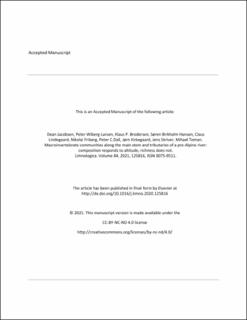| dc.contributor.author | Jacobsen, Dean | |
| dc.contributor.author | Wiberg-Larsen, Peter | |
| dc.contributor.author | Brodersen, Klaus P. | |
| dc.contributor.author | Hansen, Søren Birkholm | |
| dc.contributor.author | Lindegaard, Claus | |
| dc.contributor.author | Friberg, Nikolai | |
| dc.contributor.author | Dall, Peter C. | |
| dc.contributor.author | Kirkegaard, Jørn | |
| dc.contributor.author | Skriver, Jens | |
| dc.contributor.author | Toman, Mihael | |
| dc.date.accessioned | 2021-09-22T09:29:51Z | |
| dc.date.available | 2021-09-22T09:29:51Z | |
| dc.date.created | 2021-03-18T11:30:03Z | |
| dc.date.issued | 2020 | |
| dc.identifier.citation | Limnologica. 2020, 84, 125816. | en_US |
| dc.identifier.issn | 0075-9511 | |
| dc.identifier.uri | https://hdl.handle.net/11250/2780274 | |
| dc.description | Embargo until August 15, 2022 | en_US |
| dc.description.abstract | We collected quantitative macroinvertebrate samples and measured environmental and geographical parameters at 13 sites: six along the main stem and seven in tributaries close to the main channel over a 700 m gradient in altitude and 22 km longitudinal distance along the River Kokra in the Slovenian Alps. Our objectives were 1) to compare longitudinal patterns in richness and community composition between main stem and tributary sites, and 2) to determine the relative importance of the replacement and richness difference component for overall beta diversity and of environmental versus spatial distance on beta diversity among main stem and tributary sites. In total 138 taxa were identified. There were no differences between main stem and tributary sites in mean abundance or taxon richness (67 and 58, respectively). A nMDS and ANOSIM based on Bray-Curtis similarities found no separation of main stem and tributary sites, but that upper (≥880 m a.s.l) and lower sites (≤680 m a.s.l.) formed two different groups. In both main stem and tributaries taxon richness increased only slightly going downstream while the community composition (DCA1) was much better explained by altitude and distance from source. Overall, beta diversity (Sørensen and Bray-Curtis dissimilarity) was similar for the two groups, and total Sørensen dissimilarity was driven mainly by replacement in main stem (78 %) and tributary sites (77 %). Mantel tests showed that main stem dissimilarities were significantly correlated to environmental PCA distance, watercourse distance, overland distance and altitudinal differences. Tributary dissimilarities were not correlated to any of these four factors. GLMs showed that dissimilarity among main stem sites was explained only by altitude difference, while no factors were significant among tributary sites, even though nearly so for environmental PCA distance. The study illustrates the importance of measuring beta diversity along ecological gradients, such as river continua and/or altitudinal gradients, where alpha diversity may fail to detect relatively minor changes in assemblage composition. Such changes are likely to occur due to present and future climate warming. | en_US |
| dc.language.iso | eng | en_US |
| dc.publisher | Elsevier | en_US |
| dc.rights | Attribution-NonCommercial-NoDerivatives 4.0 Internasjonal | * |
| dc.rights.uri | http://creativecommons.org/licenses/by-nc-nd/4.0/deed.no | * |
| dc.title | Macroinvertebrate communities along the main stem and tributaries of a pre-Alpine river: composition responds to altitude, richness does not | en_US |
| dc.type | Peer reviewed | en_US |
| dc.type | Journal article | en_US |
| dc.description.version | acceptedVersion | en_US |
| dc.source.pagenumber | 8 | en_US |
| dc.source.volume | 84 | en_US |
| dc.source.journal | Limnologica | en_US |
| dc.identifier.doi | 10.1016/j.limno.2020.125816 | |
| dc.identifier.cristin | 1898949 | |
| dc.source.articlenumber | 125816 | en_US |
| cristin.ispublished | true | |
| cristin.fulltext | postprint | |
| cristin.qualitycode | 1 | |

